April 2, 2021
Air Date: April 2, 2021
FULL SHOW
SEGMENTS
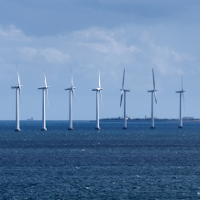
Biden Boosts Offshore Wind
View the page for this story
President Biden recently announced big plans to expand offshore wind power, with 30 gigawatts of offshore wind power along the U.S. coasts by 2030, backed up by billions in federal loan guarantees. Host Steve Curwood highlights this key part of President Biden’s infrastructure plan and how it may especially help New York City meet its clean energy demands. (02:47)
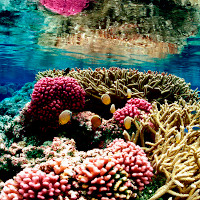
The Ocean as Solution, Not Victim
View the page for this story
The oceans are facing serious and growing threats, including climate change, overfishing, plastic pollution and more. But a group of 14 world leaders called the Ocean Panel is committing to transform the ocean from victim to solution, by sustainably managing 100% of their ocean areas by 2025. Jane Lubchenco is the Deputy Director for Climate and Environment for the White House Office of Science and Technology Policy, as well as a co-chair of the Ocean Panel Expert Group that helped ground this vision in research. She joins Host Aynsley O'Neill for more about the Ocean Panel and its vision. (11:04)
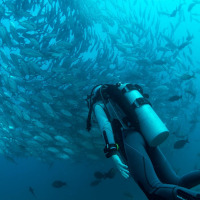
Restoring Life in the Oceans
View the page for this story
Enric Sala’s love for the ocean drew him into a career in marine biology. But as he studied marine environments across the world that have been damaged by human activity, he began to feel he was writing the “obituary of the ocean.” So he left academia to advocate for protecting the oceans as a National Geographic Explorer-in-Residence and the founder of their Pristine Seas program. With special thanks to the New England Aquarium, Enric Sala talks with Host Aynsley O’Neill about his passion for convincing decision makers to create marine protected areas, with stunning results for ocean biodiversity and local economies. (15:17)
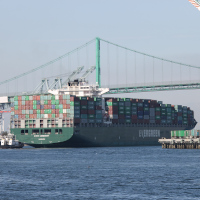
Beyond the Headlines
/ Peter DykstraView the page for this story
In this week's Beyond the Headlines segment, Environmental Health News Editor Peter Dykstra and Host Steve Curwood discuss why there was enormous natural gas flaring in the midst of the crippling power outages this February in Texas. Next, they look at how California has saved lives over the last three decades by reducing diesel emissions by 78%. Finally, they travel back to 1815, the year Mount Tambora in Indonesia erupted, circling the world in smoke and ash, resulting in what was later called “the year without a summer.” (04:07)
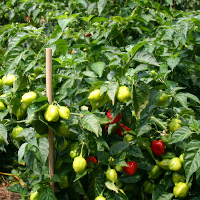
Tips for the Casual Gardener
View the page for this story
Spring is the perfect time to start gardening, and growing your favorite fresh produce doesn’t have to feel like a chore. Landscape designer Michael Weishan, former host of The Victory Garden, joins Host Steve Curwood to discuss how to work smarter, not harder when growing herbs and vegetables. (14:18)
Show Credits and Funders
Show Transcript
210402 Transcript
HOSTS: Steve Curwood, Aynsley O’Neill
GUESTS: Jane Lubchenco, Enric Sala, Michael Weishan
REPORTERS: Peter Dykstra,
THEME]
CURWOOD: From PRX – this is Living On Earth.
[THEME]
CURWOOD: I’m Steve Curwood.
O’NEILL: And I’m Aynsley O’Neill
A deep dive into the resiliency of the sea when we give time and space to nature.
SALA: That place that used to be an underwater barren was now a kaleidoscope of life and color. We were surrounded by snappers, moray eels, grunts, groupers. Everybody had come back, we saw it come back to pristine in only 10 years, I had never seen such abundance of life.
CURWOOD: Also, some tips for getting started with a vegetable garden this spring.
WEISHAN: So, you have to put in a little bit of work. But I’ll give you one tip. If you’re going to travel make sure the beds are mulched because that will preserve the water, you’ll have much less weeding and you’ll have a much more even crop. And the best kind of mulch I like for vegetable gardens is grass clippings.
CURWOOD: We’ll have those stories and more this week on Living on Earth – Stick Around!
[NEWSBREAK MUSIC: Boards Of Canada “Zoetrope” from “In A Beautiful Place Out In The Country” (Warp Records 2000)]
[THEME]
Biden Boosts Offshore Wind

The Biden Administration has set out a plan to produce 30,000 Megawatts of offshore wind energy which could potentially power 10 million homes. Pictured: Similar turbines in Copenhagen, Denmark. These 20 turbines alone provide 4% of the city’s energy needs. (Photo: Lars Ploughman, Flickr, CC BY-SA 2.0)
O’NEILL: From PRX and the Jennifer and Ted Stanley studios at the University of Massachusetts Boston, this is Living on Earth. I’m Aynsley O’Neill.
CURWOOD: And I’m Steve Curwood.
When it comes to harnessing the carbon-free energy of the wind, the United States is far behind many other industrialized nations. But if the wind portions of the comprehensive infrastructure plan the Biden Administration recently unveiled are implemented, that’s all about to change. Here’s White House press secretary Jen Psaki:
PSAKI: The President recognizes that a thriving offshore wind industry will drive new jobs and economic opportunity up and down the Atlantic coast in the Gulf of Mexico, and in Pacific waters. The Department of Interior Energy and Commerce are announced a shared goal to deploy 30 gigawatts of offshore wind in the United States by 2030 while protecting biodiversity and protecting ocean co use.
CURWOOD: Now, a standard coal fired power plant puts out about a half a gigawatt of electricity, so the Biden plan could provide the equivalent power of 60 polluting coal plants. And instead of spewing CO2, toxic particulates and mercury, offshore wind will leave the air clean. But building machines to catch the wind won’t be free. The Biden plans calls for $12 billion dollars a year over the next eight years for offshore wind power development, creating some 44,000 new jobs. Not all that money will stay at home, though. A modest and once controversial facility off the Massachusetts coast is being developed by a wind power company from Denmark, a nation with decades of wind energy experience. Of course, the Danish company may be asked to buy American-made wind turbines and the installation jobs won’t be exported. The Biden plan also calls for some 9 gigawatts of wind power in the New York-New Jersey Bight, a triangle of relatively shallow water just offshore. Julie Tighe is with the New York League of Conservation Voters:

The Atlantic Pioneer, Deepwater Wind's crew transfer vessel for maintenance on Rhode Island’s Block Island Wind Farm. (Photo: Chris Bentley, Flickr, CC BY-SA 2.0)
TIGHE: What's really important and I think why they're focused on the New York Bight is not only because we have great wind resources, but also because it is an area that has, you know, a difficulty in getting clean energy, because there's not a lot of space onshore. So offshore is really a way to get clean energy into the dense urban environment that is the New York metropolitan region.
CURWOOD: New York City has committed itself to 100 percent zero emission energy by the year 2040. And for the past 45 or so years, New York City has partially relied on nuclear energy which, despite safety and waste concerns, is carbon free. But the nuclear plant at Indian Point in nearby Westchester County is aging and its two reactors pose considerable risks in the unlikely event of a major accident. One old reactor has already been shut down and the other is expected to stop operating later this year. And their departure from the grid will leave New York short of the carbon-free electricity it needs to meet its goals. So, the Big Apple needs those Biden wind turbines in a proverbial New York minute.
Related links:
- New York Times | “The Biden Administration Announces a Major Offshore Wind Plan”
- Reuters | “Biden Targets Big Offshore Wind Expansion to Fight Climate Change”
- White House | “Fact: Biden Administration Jumpstarts Offshore Wind Energy Projects to Create Jobs”
[MUSIC: Osland Saxophone Quartet, “Concerto for Alto Saxophone & Wind Orchestra, Mvt.1” on Commission: Impossible, by Mike Mower, Sea Breeze Records]
The Ocean as Solution, Not Victim
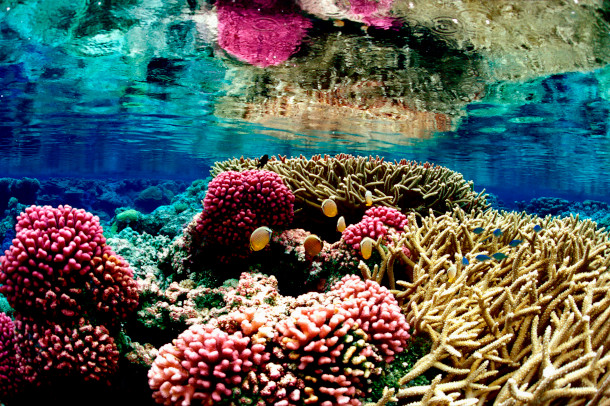
The Ocean Panel is a group of 14 countries looking to protect 100% of their ocean areas by 2025. Pictured: a coral reef in the Palmyra Atoll National Wildlife Refuge. (Photo: Jim Maragos, US Fish and Wildlife Service, CC BY-NC 2.0)
O’NEILL: Putting the oceans to work by catching some of the wind offshore is part of the Biden Administration’s plan to blunt climate disruption and reduce dangerous pollution. And the oceans are also getting a champion in the White House. Jane Lubchenco is the former Administrator of NOAA - the National Oceanic and Atmospheric Administration. She recently co-chaired a panel of experts advising 14 world leaders on how to transform the ocean from victim to a solution, with 100% sustainable management by 2025. She is now a senior member of the climate and ecology brain trust that President Biden has assembled at the White House, serving as Deputy Director of the Office of Science and Technology Policy. Before she took her White House job she spoke with us about the vision and work of the Ocean Panel. Jane, welcome back to Living on Earth!
LUBCHENCO: Thanks, Aynsley, it's a delight to be here.
O'NEILL: Now, when we look at how we currently manage the oceans, why does the world need this total transformation in management?
LUBCHENCO: The ocean is incredibly important to all of life on Earth. It's important to livelihoods, it's important to help mitigate climate change. And yet the ocean is under serious threat from a wide range of activities: climate change, pollution, overfishing, just to name a few. The current trajectory that we are on is really not good. And the question is, how can we address these underlying challenges? And part of the answer is that we need to do so more holistically than we have done in the past. We've treated a lot of these problems, issue by issue. And part of the message that the Ocean Panel leaders heard is the need for integrated solutions that consider the whole suite of human activities. The other major thing that I think they heard was that a smart future is not just doing more of the same. It's actually doing things differently, being much smarter about how we fish, much smarter about how we produce energy, much smarter about how we transport goods around the world. And so much of what is in their new, exciting Ocean Action agenda is doing things smarter, more effectively, more efficiently, and also doing things more holistically.

The Ocean Panel envision utilizing their ocean areas as a solution to climate change, rather than simply the victim of it. Pictured: a mangrove lagoon on the coast of St. Thomas in the US Virgin Islands. (Photo: Marco Verch, Flickr, CC BY 2.0)
O'NEILL: Now, Jane, what are some of the most important ways that a sustainable ocean economy connects with climate change?
LUBCHENCO: That's a great question. In September of 2019, we had a new report that came out from the IPCC, the Intergovernmental Panel on Climate Change. There was a special report on the ocean and the cryosphere, and it painted in very depressing detail, all of the ways that the ocean has been massively affected by climate change and ocean acidification. And it was clear from that report that the ocean is indeed a victim of climate change. It's not just the changes in the weather patterns, and the extreme heat, and the droughts, and the megastorms that we're seeing on land. But the impacts of climate change to the ocean have been very, very significant. But the same week, the Ocean Panel unveiled a report that it commissioned that asked the question, what is the potential for the ocean to provide solutions to help mitigate climate change. And before that report, when people thought about climate change in the ocean, they either thought about the impacts that I just referred to, or they thought about the ocean being important for adaptation. But very rarely has the international policy community focused on climate mitigation thought about the ocean. The report that the Ocean Panel commissioned, looked at a variety of ocean based activities and asked simply, what is the potential for mitigating climate change, and they found enough data at the global scale to analyze five categories of activities. And when they added up how much they could get from each of those five, they came to the astounding conclusion that it might be as much as 1/5 of what we need, by way of carbon emission reductions to achieve the 1.5 degree centigrade target of the Paris Agreement by 2050. So that's huge. You know, a lot of those activities weren't even on the table. And here, we find that they actually could play a very significant role in helping to turn things around in terms of climate change.
O'NEILL: So Jane, you mentioned five ocean based activities to help mitigate climate change. Could you go through those for us, please?
LUBCHENCO: So the first one was increasing renewable energy from the ocean, and that's a big one. Most of that is going to likely be wave energy, but it might also be tidal, it might be current, it might be thermal, depending on what part of the world you are in. The second category was making shipping less polluting. So 90% of the goods that are traded globally travel by ocean and currently, that's pretty polluting. It's dirty fuels, they contribute significantly to greenhouse gases. But it is technologically possible to decarbonize shipping, and that could have a huge benefit. Number three is focusing on what we call blue carbon ecosystems. So these are coastal and ocean ecosystems, such as mangroves, salt marshes, or seagrass beds, that are little carbon engines that are just sucking carbon out of the atmosphere like crazy. Those habitats; mangroves, sea grasses, salt, marsh beds, can not only remove but then sequester as much as 10 times as much carbon as an equivalent area of forest, for example. And we've currently lost about half of them globally. So here is an opportunity to actually protect the remaining ones, but also to restore those that have already been degraded. The fourth area for ocean based activities to mitigate climate change comes from focusing on a little bit greater efficiency with aquaculture, mariculture operations, a little bit greater efficiency, with fisheries. But the big one in this category is really shifting diets globally, away from animal protein on the land, and including animal protein from the sea, instead of that animal protein from the land. And then the fifth category was simply sequestering carbon on the seabed. And the panel who looked at these five categories, said that the first four, they felt completely comfortable recommending that they be pursued aggressively. Smartly, yes, but aggressively. This fifth one, carbon storage in the seabed has a lot of questions still about technical and environmental impacts. And so they recommended further study for those. But that's another deep dive, if you will, into the potential of the ocean, to not just be thought of as a victim of climate change, but as a solution to climate change by providing as much as 1/5 of the carbon emission reductions that are needed to get us to the 1.5 degree target by 2050.
O'NEILL: To what extent is it important to frame this vision as an opportunity, as opposed to a sacrifice for the countries involved?
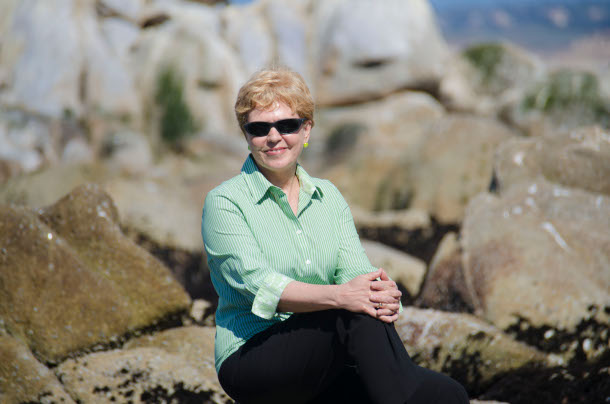
Jane Lubchenco is a former NOAA Administrator and currently serves as Deputy Director for Climate and Environment for the White House Office of Science and Technology Policy, on leave from Oregon State University. (Photo: Oregon State University, Flickr, CC BY-SA 2.0)
LUBCHENCO: You've really hit the nail on the head, Aynsley. This is really the secret sauce here. There has been a lot of focus on the ocean as doom and gloom. And there are a lot of problems. There's no sugarcoating that. There are a range of very serious challenges underway to the ocean right now. However, we also see looking around the world, some amazing solutions that have come to light, that have developed in this community, or that country, or this industry. And those solutions are bright lights. Collectively, they aren't at the scale that's needed. They aren't at the pace that's needed. But we have the benefit of a huge range of potential solutions that if they were adopted and implemented, could actually transform how we think about and how we use and how we benefit from the ocean in ways that are truly opportunities. So this is not really sacrifice. It's being smarter about doing things. I think people are familiar with the concept of greater efficiency when we think about energy. You know, much of the focus for mitigating climate change has been focusing on how do we use energy more efficiently. And there have been tremendous advances in energy efficiency of our appliances, of our automobiles, of our transportation systems. That same concept of being more efficient, is what underlies a lot of the transformative actions that are in the ocean action agenda. So yes, this is an incredible opportunity. And it's my belief that these 14 nations that have embarked on this journey of discovery and now journey of action will have such success with what they are proposing that others will say, oh my gosh, I want some of that too. I want to join forces because what they are doing is exactly what the world needs.
O'NEILL: Jane Lubchenco is a co-chair of the Ocean Panel expert group. Jane, thank you so much for taking the time with me today.
LUBCHENCO: It's been great. Ainsley. Thank you so much.
Related links:
- More on the Ocean Panel
- National Geographic | “In Rare Show of Solidarity, 14 Key Nations Commit To Protect Oceans”
- More on Jane Lubchenco
[MUSIC: Keola Beamer, “Hula Lady” on Wooden Boat, by Carlos Andrade and Vinnie Bryant, Dancing Cat Records]
CURWOOD: Coming up – the surprising speed at which the oceans can heal themselves. Keep Listening to Living on Earth.
ANNOUNCER: Support for Living on Earth comes from Sailors for the Sea and Oceana. Helping boaters race clean, sail green and protect the seas they love. More information at sailors for the sea dot org.
[CUTAWAY MUSIC: Eugene Friesen, "The Rest Of My Days" on In the Shade Of Angels, by Eugene Friesen and Tim Ray, Fiddle Talk Music]
Restoring Life in the Oceans
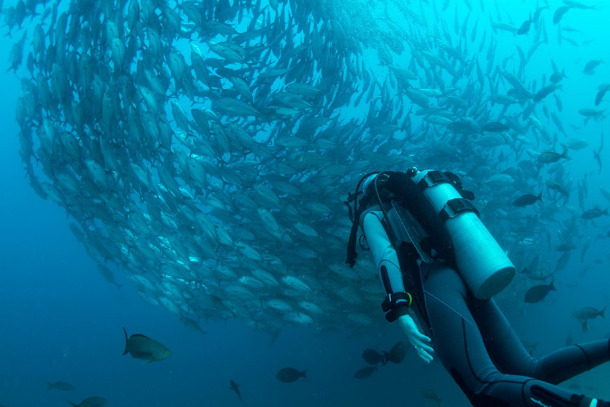
A diver faces a tornado of fish in Cabo Pulmo, Mexico. The creation of a protected area in Cabo Pulmo proved a boon for local fishermen, boosting the amount and diversity of fish. (Photo: Pascal Van de Vendel via Unsplash, CC 2.0)
CURWOOD: It’s Living on Earth, I’m Steve Curwood
O’NEILL: And I’m Aynsley O’Neill.
Earlier in the broadcast we heard about reframing the ocean as a solution instead of a victim. A big part of that means helping the oceans recover from our overfishing, plastic pollution, and climate impacts. And we’ve got to hurry. Marine vertebrate populations declined by half between 1970 and 2012, according to the World Wildlife Fund. So when it comes to looking at the ocean as a solution, it’ll take someone with a bold vision. Someone like Enric Sala, Explorer-in-Residence for National Geographic and the cofounder of its Pristine Seas project. He’s always had his eye on that blue horizon.
SALA: When I was a little kid growing up on the Mediterranean coast, I was very close to the beach, which I visited every summer with my parents. And we were watching all Jacques Cousteau’s documentaries on TV. Since I can remember I wanted to be a diver, an explorer in Jacques Cousteau's boat.
O’NEILL: Oh, I love that. My father is a big fan of Jacques Cousteau, so.
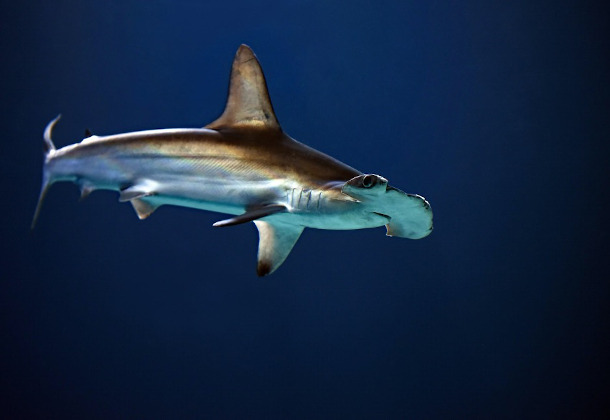
Hammerhead sharks are named for their unusual head shape. (Photo: David Clode via Unsplash, CC BY-SA 2.0)
SALA: Well I was born too late to be a diver in the Calypso, in Cousteau's boat, but the path that I took was science.
I decided to do my PhD studying a little marine reserve, an area where fishing is banned off the coast of Costa Brava in the Mediterranean coast of Catalonia. And then I became a professor.
But then one day I realized that all I was doing was writing the obituary of the ocean.
I was describing how ocean life was dying because of too much fishing and because of global warming. And that day I decided to quit academia and dedicate my life to bring back the richness and the productivity of the ocean.
[MUSIC: Blue Dot Sessions, “Shift Of Currents (Atmospheric var.),” Aeronaut, Blue Dot Studios 2020]
O’NEILL: Enric wanted to protect and restore places like the Galapagos Islands, which I was lucky enough to visit back in college for a study abroad program.
As far away as the islands are now, Enric took me back there in a heartbeat.
SALA: Yeah, I love the Galapagos Islands. Actually, the Galapagos Islands, they harbor the largest biomass of sharks ever measured in the ocean.
O’NEILL: Wow.
SALA: And you jump in the water. There is a shallow reef platform at around 30 feet. So you go down and you grab the rock for, [LAUGHS] you know, for your life, because the current is very strong. And then you just wait wait, wait, wait, wait.
[MUSIC: Blue Dot Sessions, “Leave the TV On,” Lemuel, Blue Dot Studios 2017]
And then after a while… one shadow came from the deep.
And then another one.
And then 10.
And then 100.
And then all of a sudden, you are seeing a wave of 200 hammerhead sharks swimming above you.
And then you think oh my god, I can die now, I have seen the most beautiful thing in the world.
And then when you think that you have seen it all, then you turn your head to the other side, and there comes a 40, 45 feet long whale shark. The biggest fish in the ocean.
So these are the type of things you can see at a wild place, like the Galapagos Islands.
[MUSIC FADES]
O’NEILL: Without those kinds of wild places, it’s impossible to even know what we’re missing.
SALA: As I mentioned earlier, when I was a little kid watching the documentaries of Jacques Cousteau, I was so excited to see all these big fish and the sharks and the dolphins and kelps. But then I went swimming in the Mediterranean and there was none of that. The sea floor was a barren ground with sea urchins. No kelps, no big fish, no dolphins, no seals, no sea turtles. And I was confused, and I thought that the Mediterranean was a naturally poor sea.
But then when I turned 18, and I was allowed to scuba dive, I took a diving course and my first dive in the sea was at this Medes Islands Marine Reserve, which had been protected for 9 years. And as soon as I got in the water, I realized, wow. This is what Cousteau showed us. This is what the Mediterranean used to be like. This is all that we have lost.
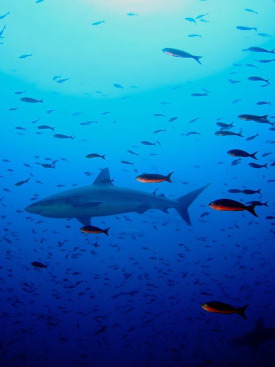
A Galapagos shark swims through a group of reef fish. The Galapagos Islands are home to the largest biomass of sharks ever recorded. (Photo: Daniel Kwok, CC BY-SA 2.0)
[MUSIC: Blue Dot Sessions, “Shift Of Currents (Original),” Aeronaut, Blue Dot Studios 2020]
O’NEILL: Bringing that back is what Enric now advocates for as an Explorer in Residence with National Geographic.
Their Pristine Seas program, which he founded, uses exploration, research, and media to convince presidents, governors, and local leaders to protect the wildest parts of the oceans with Marine Protected Areas.
These are basically nature reserves, or national parks, just for water instead of land.
The platonic ideal would be an area free of fishing, mining, and drilling.
And Enric knows first hand what that can do, even in a place that seems beyond repair.
SALA: The good news is that if we give the ocean space, marine life can comeback spectacularly. And I know because I have seen it.
O’NEILL: Tell us a little bit about one of those success stories where you've seen that in action and seen what can happen.
SALA: There is a place in Baja California, in Mexico called Cabo Pulmo. I was there in 1999, a couple of years after I arrived to my job at Scripps Institution of Oceanography. And the place was not very special except for the corals. There were not many large fish there.
The fishermen were so upset with not having enough fish to catch that they did something that nobody expected.
Instead of going after the last few fish left, which is what people normally do, they decided to create a no take area.
[MUSIC: Blue Dot Sessions, “Leave the TV On”, Lemuel, Blue Dot Studios 2017]
They asked the Mexican government to create a national park in the sea.
When we returned 10 years later, everything had changed.
That place that used to be an underwater barren was now a kaleidoscope of life and color.
[MUSIC GROWS, EXPANDS]
We were surrounded by snappers, moray eels, grunts, groupers. Everybody had come back, we saw it come back to pristine in only 10 years, I had never seen such abundance of life.
We actually measured fish, as good scientists, and compared the 2009 with the 1999 fish abundance; the tons of fish per hectare increased by 450%.
[MUSIC FADES OUT]
O’NEILL: Wow.
SALA: That was, that was the largest absolute recovery of fish abundance we've ever measured in a marine reserve worldwide. And we saw the return of the large predators, like the groupers, and the sharks, and the jacks. It's an extraordinary place.
And you know who else is thriving? Those visionary fishermen, who now are making far more money from diving tourism inside the reserve and better fishing around it.
O’NEILL: Wow. I can only imagine but I really want to see it myself! [LAUGHS]
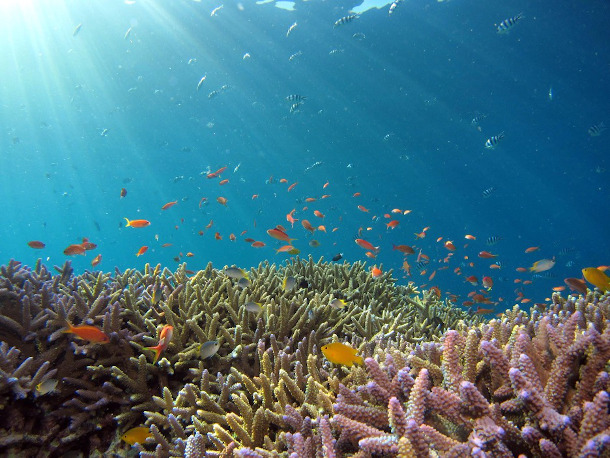
A coral reef in the Okinawa Sea blooms with life. Protecting key areas of ocean biodiversity with marine protected areas can have outsized, positive impacts on surrounding ecosystems. (Photo: Hiroko Yoshii, CC BY-SA 2.0)
[MUSIC: Blue Dot Sessions, “Leave the TV On,” Lemuel, Blue Dot Studios 2017]
SALA: You should go, it's an extraordinary place. It was some of the best diving in the world.
O’NEILL: After the break, we’ll dive into how Enric Sala gets people onboard with marine protected areas -- and whether or not the idea really holds water.
[MUSIC: Blue Dot Sessions, “Leave the TV On,” Lemuel, Blue Dot Studios 2017]
CURWOOD: To get the stories behind the stories on Living on Earth as well as special updates please sign up to the Living on Earth newsletter. Every week you’ll find out about upcoming events and get a look at show highlights and exclusive content. Just navigate to the Living on Earth website that’s LOE.org and click on the newsletter link at the top of the page. That’s LOE.org.
[MUSIC: Blue Dot Sessions, “Leave the TV On,” Lemuel, Blue Dot Studios 2017]
O’NEILL: Let’s dive back into our story about bringing back abundant life in the oceans with Enric Sala.
He’s the founder of the National Geographic Pristine Seas project, which advocates for creating Marine Protected Areas to preserve the wildest parts of the ocean in their natural state.
So, Cabo Pulmo is a shining case study of how no-take areas can help everybody, including fishermen
Still, how do you really convince decisionmakers? You’ve got to be realistic, Enric says…
SALA: When I was in academia, I thought that data was all that was needed.
That if decision makers, policymakers, had all the information about something, they would make a rational and informed decision.
But of course, I was so wrong. I was in the ivory tower, and I didn't know how the world worked. And when I left and came to National Geographic to start our Pristine Seas program, we learned very quickly that first we have to make people fall in love with these places.
O’NEILL: Now I feel like I've always been in love with the ocean, but if somebody is sort of reluctant, what's the best way to make someone fall in love with the ocean?
SALA: Every time we have taken somebody to one of these remote pristine places, they invariably fall in love with the place.
It is very difficult for a human with a heart and a soul to see such beautiful nature, it can be an old growth forest…
… it can be snow-capped mountains…
… it can be a pristine coral reef or a kelp forest.
It would be very difficult for a human to see these places and not fall in love with them. And I know there are people who are not so friendly to our life support system. And so probably these people lack heart and soul.
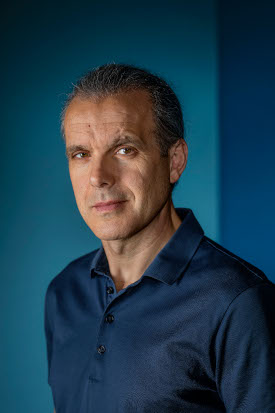
Enric Sala, PhD. is an explorer in residence at National Geographic and co-founder of the Pristine Seas project. (Photo: National Geographic)
[MUSIC: Blue Dot Sessions, “Shift Of Currents (Original),” Aeronaut, Blue Dot Studios 2020]
O’NEILL: And for those who lack the ‘heart and soul’, as Enric put it, that’s where the facts and data come in.
Before the break, Enric mentioned that the fishermen in Cabo Pulmo actually made more money after they designated the reserve - thanks to a sizable diving tourism operation.
Ecotourism in general is a massive industry - in the average non-pandemic year, it generates something like $265 billion dollars worldwide.
Places like Cabo Pulmo, the Galapagos, Rainbow Reef in Fiji, and of course the Great Barrier Reef in Australia are magnetic for divers and snorkelers from all over the world.
And if these travelers happen to stop by a gift shop or restaurant on their way, it’s all the more lucrative for the local economy.
That’s not to mention other ecosystem services that marine protected areas can provide: cleaning up wastewater, absorbing carbon dioxide, and pumping out oxygen for all of us on this planet to breathe.
And Enric says protecting these places demands that kind of scale.
SALA: The science is telling us that we need half of the planet, land and sea, in natural state, if we are to prevent the extinction of 1 million species, the collapse of our life support system, and if we are to achieve the goals of the Paris Climate Agreement. We need all these intact large ecosystems to continue absorbing much of the carbon pollution that we expel into the atmosphere. And we can start by committing to protect at least 30% of the ocean, fully protected, or highly protected, by 2030.
That’s what the science is telling us is the minimum that we require to make sure that the ocean continues providing for us.
[MUSIC: Blue Dot Sessions, “Open Flames,” Aeronaut, Blue Dot Studios 2020]
O’NEILL: 30% by 2030 seems like a tall order, and it is.
Right now, only 7 percent of the ocean is under some form of protection.
But it’s a start:
The United Kingdom has 355 marine protected areas, covering a quarter of their water, while Seychelles and Chile have already protected 30% or more of their own national waters.
And the gold medal goes to Palau, having protected 80% of their waters with a marine sanctuary that’s larger than “the Golden State”, California.
So some countries are leading the charge in marine protection.
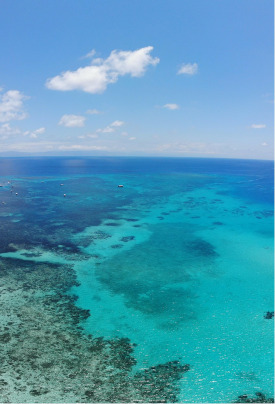
The Great Barrier reef is the world’s largest coral reef system. It is also a hub of lucrative ecotourism, where people come from all over the world to scuba dive and snorkel amongst the corals. (Photo: Carles Rabada via Unsplash, CC BY-SA 2.0)
And the US is moving in that direction too.
President Biden set a goal of setting aside 30% of land and ocean by 2030 with an executive order earlier this year.
Still, Enric isn’t letting his guard down.
SALA: Well, we have two problems here. One is that most of the protected areas are not protected enough. Most of these areas allow fishing within their boundaries.
And the second problem is that even if the areas are well regulated, they are not enforced. It is ridiculous that countries propose marine protected areas that allow commercial fishing, including bottom trawling, within their boundaries. You know, bottom trawling, which is a medieval practice for obtaining food where you have these huge nets that scour the bottom of the ocean to catch fish and shrimp, and everything that is caught and destroyed and dead that is not commercial is thrown overboard. And it just takes one pass of the net to kill everything, including thousand year old corals.
So these areas are not protected, they should not be called protected. This is a joke. So we need to make sure that most of these areas that allow so much commercial fishing are fully protected.
Because what the science is telling us is that the higher the level of protection, the greater the benefits for everybody, including fishing. These no-take areas, these fully protected marine areas, are savings accounts with a principle that we set aside, that grows like compound interest, and produces returns that we all can enjoy, including the fishermen.
O’NEILL: So let's say, miracle of all miracles, tomorrow, we have protected 30% of the ocean and it's even being enforced. Goodness gracious. How long is it going to take the oceans to recover even with that?
SALA: We have been able to detect differences, significant increases in marine life, within three to five years. For some species, it's very fast: there was a moratorium of fishing anchovies in northern Spain, it only took two years for the fish to come back.
In Cabo Pulmo in less than 10 years we saw it come back to pristine. In other places, like in Kenya or Fiji, small marine reserves helped to increase, in some cases double, the income of the fishermen in only three years.
It's very easy to fall into the doom and gloom, because there are many problems affecting the ocean. But the good news is that if we give space to the ocean, ocean life comes back spectacularly. I know because I've seen it. We just need to do it again and again and again.
[MUSIC: Blue Dot Sessions, “Open Flames,” Aeronaut, Blue Dot Studios 2020]
O’NEILL: That’s Enric Sala, cofounder of Pristine Seas and explorer in residence at National Geographic.
(Special thanks to the New England Aquarium for assistance with this segment.)
Related links:
- The Pristine Seas Project at National Geographic
- Enric Sala’s Personal Website
- VIDEO: Why Are Marine Protected Areas Important? | Scripps Oceanography
[MUSIC: Blue Dot Sessions, “Open Flames,” Aeronaut, Blue Dot Studios 2020]
Beyond the Headlines
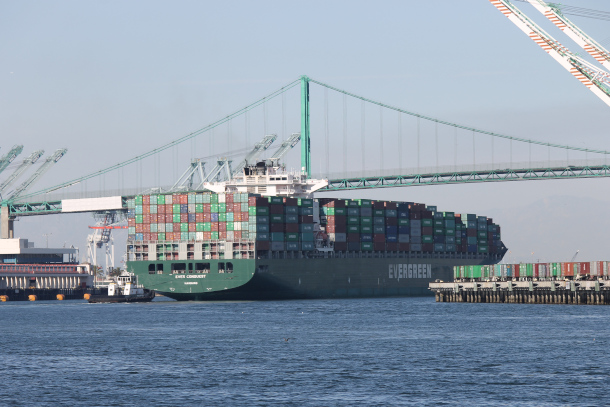
Researchers calculated that California’s rules reduced diesel exhaust by 78% compared to 51% for federal rules, through regulations for shipping, buses, and cars. These changes led to fewer deaths from heart attacks and lung disease. Pictured: The Ever Conquest Container Ship in the Port of Los Angeles, which adjoins the Port of Long Beach. (Photo: Corey Seeman, Flickr, CC BY 2.0)
CURWOOD: Well, let's take a look beyond the headlines now with Peter Dykstra. Peter's an editor with Environmental Health News that's ehn.org and dailyclimate.org. On the line now from Atlanta, Georgia. Hey there, Peter, how you doing and what have you got for us today?
DYKSTRA: Well, Steve, I'm doing okay. Except like a lot of people, I'm battling the pollen here in the southeast. A friend of mine posted a picture of Lake Lanier, a big lake north of Georgia, and there was what appeared to be from an aircraft, almost an iceberg of pollen floating down the lake. But I'm coping with it, the rest of us are coping with it. And that's the one downpart to what's going to be a beautiful spring.
CURWOOD: Well, and you have got to admit that the trees and flowers love the pollen. Hey, what do you have for today?
DYKSTRA: Well remember, last month, frigid temperatures in a lot of places. Texas got hit really hard, and unexpectedly, the oil and gas industry got hit extra hard. Machinery, pipelines are frozen, companies had nowhere to move their natural gas even if they could, because the electricity they needed to run natural gas facilities and pipelines was nowhere to be found as the Texas grid failed. So the only choice that gas producers had in Texas was to increase their already toxic venting of greenhouse gases, particularly methane, by a factor of five, all wasted, and the only thing it could do is contribute to a warming climate.
CURWOOD: Instead of warming the people who were freezing in their homes with the power grid out since they mostly used electricity to stay warm. Hey, what else do you have for us today?
DYKSTRA: This is from another big state, California, and it's potentially good news. California, of course, has led the nation in being aggressive about sources of air pollution. Their rules on diesel exhaust may have shown a huge health benefit. California's crackdown on diesel fumes from passenger vehicles, planes, locomotives, construction equipment, reduced the impact of those diesel fumes by 78% last year. Compared to 51%, for all the states still operating under the more lax federal rules.
CURWOOD: Wow. So they saved a bunch of lives. And of course, during this pandemic, we know that particulates from fossil fuel, including diesel, make COVID worse, make people more likely to get sick and die.
DYKSTRA: And all of the factors that go into either failure or success in dealing with COVID, this is a unique one. But it's a big education on how conscientious enforcement can save lives and make our air easier to breathe.
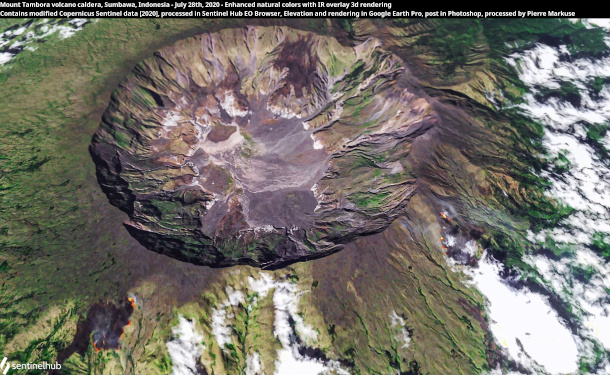
The eruption of Mount Tambora created a global haze of smoke and ash, plunging the world into what is known as the year without summer. (Photo: Pierre Markuse, Flickr, CC BY 2.0)
CURWOOD: Just recently, Peter, we saw the studies showing that around the world some 8 million people every year die from particulates from burning fossil fuels and 300,000 a year right here in this country. So now it's time for us to go to history class with Professor Dykstra, and what do you have for us today?
DYKSTRA: I've got 'Volcanoes for 400' Steve.
CURWOOD: Okay.
DYKSTRA: Indonesia's Mount Tambora erupted on April 5, 1815. It's a 13,000 foot peak that in a flash became a 9000 foot mountain. The top of that mountain sent dust and smoke and aerosols around the world in what was later called the year without a summer.
CURWOOD: Yeah, that's right. When volcanoes erupt, they have these particulates that go in the high atmosphere and can kind of block out sunlight. How much did temperatures decline with this eruption of Tambora? Do you know?
DYKSTRA: It may be around three degrees Fahrenheit, and in some parts of the world, famine and malnutrition and starvation followed.
CURWOOD: Alright well thanks Peter, Peter Dykstra is an editor with Environmental Health News that’s EHN.ORG and Dailyclimate.org, we’ll talk to you again soon.
DYKSTRA: Okay, Steve, thanks a lot, talk to you soon.
CURWOOD: And there's more on these stories at the Living on Earth website, that's loe.org.
Related links:
- The New York Times | “Drillers Burned Off Gas at a Staggering Rate as Winter Storm Hit Texas”
- Cal Matters | “New study: California’s trailblazing diesel rules save lives”
- Smithsonian Magazine | “Blast from the Past”
[MUSIC: Oumou Sangare, “Saa Magni” on Africa Fete 3, by O. Sangare, Mango Records]
O’NEILL: Coming up – getting back to the garden. That’s next on Living on Earth.
ANNOUNCER: Funding for Living on Earth comes from you, our listeners, and United Technologies, combining passion for science with engineering to create solutions designed for sustainability in aerospace, building industries, and food refrigeration.
[CUTAWAY MUSIC: Eugene Friesen, “I’ve Always Hated Those Big Violins” on In the Shade Of Angels, by Eugene Friesen, Fiddle Talk Music]
Tips for the Casual Gardener
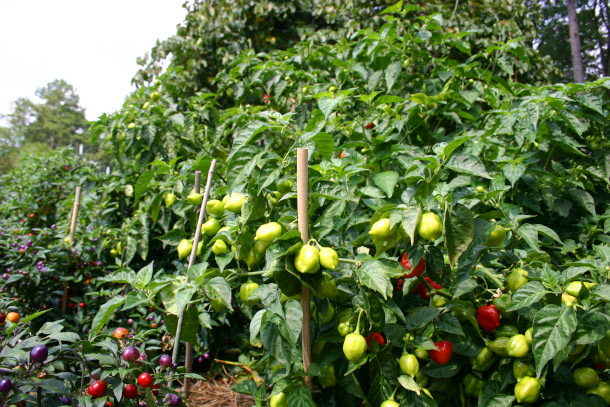
Ace bell peppers are a wonderful option for gardening because they are prolific and mature from dark green to red providing multiple cooking options. (Photo: Bruce Dupree, Flickr, Public Domain)
O’NEILL: It’s Living on Earth I’m Aynsley O’Neill.
CURWOOD: And I’m Steve Curwood
Spring is here in the North and that makes it the perfect time to start a garden. And according to Michael Weishan there are ways of working smarter not harder and still having a bounty of delicious produce. Michael is a landscape designer, a veteran of Living on Earth and former host of the Victory Garden on PBS. He joins me now to share some tips on how to smooth your way into gardening without breaking your back or the bank. Michael Weishan, Welcome back to Living on Earth!
WEISHAN: I am so happy to be here Steve.
CURWOOD: Now I have to confess something and that is, while I've been very consistent about doing the broadcast over these last 30 years, I've been less consistent about gardening, traveling a lot in the summer not really able to attend to a garden. But this year, because of some delightful family changes, there's a grandchild in the neighborhood nearby. I won't be gone as much during the summer. And I thought, well, maybe I should start growing things to eat again, right? I mean, that's what gardens are for, right? Eating?
WEISHAN: Well, gardens are about pleasure. I mean, that's my version of it. A landscape, a garden should be about giving something back to you. So if your desire is now some fruit and vegetables that can be managed.
CURWOOD: Well, I have a wonderful wife, Jennifer, who takes care of the perennials and so we get that beauty that's really nice to have from a garden. But I'm thinking, I'd like to get started again, with something you know, fairly simple, maybe in a raised bed, out my kitchen door which can get plenty of sunlight depending on where I might put a raised bed and growing something that would be edible and would be tolerant if I do you happen to be away for a couple of weeks.
WEISHAN: Well the raised bed idea is a really good idea and as I'm getting older I appreciate it more and more. It was always a good idea because raised beds drain better. They're very easy to install too you can you know, choose a plot of grass, for instance, and just put the structure however is raising it with stone or timber whatever and then fill it with soil right over the existing lawn so you don't have to rototill, it's much easier to construct. It warms up quicker in the spring and now as I'm heading for my 60th year, I hate to even say that it is a lot easier to get down there. I find about 10 inches is the ideal, ideal height, because that gets you up just enough where it's very easy to you know, to bend over and do something but not too high so that if you need to put a wheelbarrow full of soil or you want to put something into it, you can still make that transition without it being you know, two feet and very impossible, very hard to do.
CURWOOD: Okay, I have to confess Michael, I'm not exactly the hardest working gardener in fact I'm downright lazy. So for this year to try to get back in the game, what do you recommend for the kinds of vegetables, the edible plants and alright, you can tell me that maybe I need to have a bit of something that has a beautiful blossom on it as well in there. But what are some of the things that I should try to grow in this raised bed?
WEISHAN: Well, you know, here's the question. People always ask me what I should grow, you know, what should I grow? And the answer to that is what d you like? And then you take triage of that selection about as to what is possible. So first of all, you have a site in full sun, right, Steve?
CURWOOD: We do. Yeah, I do have one.
WEISHAN: That's eight hours of sun a day, you know, no cheating.
CURWOOD: No cheating, yes.
WEISHAN: All right so that gives us a huge range of possibilities. So now tell me what you like to have at the table.
CURWOOD: Well, so I'm going to be nostalgic for a moment. I've had in the past great luck growing basil, for example. And then later in the season, when I harvest the basil and I get some pine nuts and a bit of olive oil, I wind up getting pesto which I get to keep in the freezer all winter long, so that's something that I really enjoy. It almost seems that the basil is idiot proof of I keep it in if it's in the sun and gets decent water, right?
WEISHAN: Yeah, yeah, pretty well. Sometimes it's susceptible to various fungal problems so if it's a very wet summer, sometimes it'll go down. But yeah, most of the herbs I mean, you can buy little pots of herbs and grow them for the summer, fresh thyme for instance, oregano, basil, all that parsley, for instance, which I really like it goes so well in so many different kinds of things. But you know, so I guess the question is, so what you would like to grow and also what's cost effective to grow.
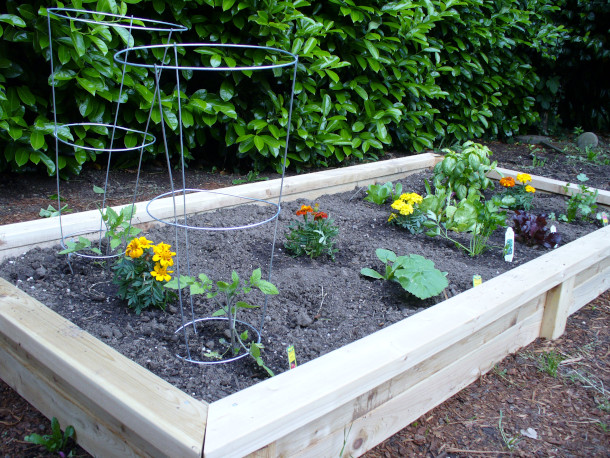
Raised Beds allow for a longer growing season because they warm up more quickly in the spring and as long as the soil is properly prepared, they drain better. (Photo: Celeste, Flickr, CC BY-NC 2.0)
CURWOOD: Okay.
WEISHAN: A lot of people say to me, okay, well, you know, I like this and I like that. For instance I love carrots but I don't grow carrots because carrots are a buck fifty at the market. And they're very fussy to grow yourself because they're very fine seeds, you have to weed them constantly, you can't mulch them individually. And if you don't have really deep perfect soil, they get all crooked so that would not be my choice. Now I am a huge fan of both peppers and tomatoes.
CURWOOD: Oh tomatoes! Now so here's the problem I have with tomatoes. That is at a certain point, the plant looks really ugly and you know as it kind of gets on. So, but I do love tomatoes and nothing like a fresh cherry tomato sometimes just loaded with sugar and the large ones too, are great fun. So the guide me in the area of tomato and how I can keep them looking better.
WEISHAN: You can't really keep them looking better and the problem is that a few years ago in New England, this late blight was introduced, which is a very veracious disease that just really consumes the plants, the fruit, the whole thing starts to collapse and once it does, it's over. You know, you can try fungicides, but I don't because you know, I don't really want to be eating that stuff. It used to be we would have tomatoes till frost, they didn't look right, but you'd have them right till frost. Now we're lucky if we get tomatoes through the end of August, early September, which is a month and a half before our frost time here. Interestingly, this year I have been experimenting with growing or will be starting because we're about to seed next week, some different varieties that are made to be resistant to this late blight. I don't have any experience with them yet but if you go through the catalogs for instance, you can see you know, late blight resistant late blight resistant or we're trialing that for this. So that's one of the tips is to look at the plants and their disease resistance. And so again, you know, the things that you like, so I go the things I like and things that are expensive.
CURWOOD: Okay.
WEISHAN: Before air we were talking about you have a little raspberry patch, right?
CURWOOD: Right.
WEISHAN: Well that's something I always tell people to grow because raspberries are unbelievably costly and they're unbelievably easy to grow. If you prune them back at the proper time they just produce raspberries by the gallon practically. So you know, that's a phenomenal part to have something to have in your garden.
CURWOOD: Hey before we move on from raspberries. How do you get a new set going?
WEISHAN: Well, you can divide them, you can just dig them up in the spring and pull apart the canes and plant new ones. Because they spread by underground runners, right. So you can just chop them off and redistribute them. As long as the plants are healthy, sometimes they go down with various blights and fungal diseases. After a number of years they start to lose productivity. If that's the case, then just buy some new canes fresh and started a new bed. But I've had great luck. I think the raspberries I have here, which are a thornless variety called candy which is very nice for picking so you don't get stabbed. It's a terrific terrific variety.
CURWOOD: Alright, continue now with a raised bed and some vegetables and the salad greens like romaine or arugula, which some people are some varieties are known as rocket, maybe some some herbs of cilantro or I suppose the basil will be fine in there. And then you suggested that peppers can be expensive and really good to grow in a raised bed. What do you have in mind?
WEISHAN: Well, for the New England area there's a variety called ace which is the only one that I've ever gotten to grow successfully that has more bell peppers than you've ever. I love stuff bell peppers, so it has more peppers than you could ever use in a season. And the nice thing about this right is it starts green so if you like the green, you can have them green and then it matures through yellow to red. So you can go all the way to whatever color you like and they each plant produces I don't know, half a dozen or a dozen bell peppers, whatever weather whether it's hot or cool. A fantastic variety. The farther south you get you have a much larger selection of peppers, because they really require heat. But I grow a whole group of them. But again, you know, peppers. Some good peppers are really expensive, even in the summer market. So why not grow? It's easy to produce.
CURWOOD: Yeah, they can get a buck or even two bucks just for a single pepper sometimes.
WEISHAN: Yeah, exactly. And when you grow them yourself, I mean, it's a much, much better process. I also like to grow spinach. I know spinach is cheap but it's really fantastic when you have it just fresh because you can keep picking the the individual leaves. And another real favorite of mine especially now early in the season are sweet peas, you can have snow peas, you can have regular fleshy type peas. I mean, the whole process of just picking your own fresh peas and then putting them right into a recipe in the early spring is just phenomenal.
CURWOOD: And of course the peas if I recall back when I was a little more active in growing things, they'll be gone by the time some of these other things are ready for the raised bed.
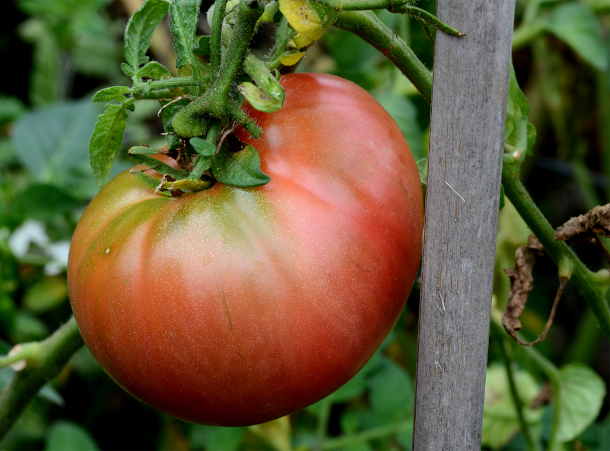
Tomatoes are very prolific, one ounce of tomato seed can produce up to 7,400 plants. (Photo: Stephen Melkisethian, Flickr, CC BY-NC-ND 2.0)
WEISHAN: And then you get into the whole thing about sequencing and so this is the other other issue. You don't necessarily need a huge space, right? Because you're growing early crops. For instance, you can grow scallions now you can start putting out not quite now but very, very soon and certainly to the south of us now. And then they're quickly harvested and then replaced by say tomatoes or peppers. You can grow peas early on, and then those are replaced by vegetable crops later on. There are also some really small types of diminutive summer squashes. You know, generally the zucchini the summer squash they get to be these huge bushes. But there are various new varieties out that are quite compact. And you know if you harvest them early not wanting them to get into these like baseball size..
CURWOOD: Baseball bat size.
WEISHAN: Yeah, exactly! Monstrosities. When you can do really nothing with them. When they get that size I just throw them to the chickens because the chickens just eat them. But after that you know when they're that says they're just get tough but if you pick them young and fresh, grilled with a little fresh dill ah fantastic! With olive oil, fresh dill, little salt, throw them in some aluminum foil, throw them on the grill, cook them till they're tender. Perfect accompaniment to chicken or brass or steak or any type of grilled meat. Fantastic.
CURWOOD: So I'm going to check in with you after I've tried this for a while Michael and, and see how I've, I've been doing.
WEISHAN: Now remember, you can't be a lazy gardener. [LAUGH] There's no such thing as being a lazy gardener, lazy gardeners go to the supermarket. So you have to put in a little bit of work. But I'll give you one tip. If you're going to travel a little and you go about your business during the summer make sure the beds are mulched because that will preserve the water, you'll have much less weeding and you'll have a much more even crop. And the best type of mulch I like for vegetable gardens is grass clippings. You know, you just bag it from your mower and spread the grass clippings about a vegetable plants they break down very fast, very nutritious, and they don't linger too long so when you rotate the crops you're able then to you know push them aside and get the new plants in without too much trouble unlike say wood chips.
CURWOOD: Now, one last question about this raised bed area. The dimensions? Yeah, 10 inches off the ground. But how big a raised bed does it make sense to have? For the alright, no such thing as a lazy gardener but for the gardener who has other chores in his or her life to deal with as well?
WEISHAN: Well, so this is a question I get a lot too because it's an interesting compromise between productivity and space. So the worst thing you can possibly do is to open a really large space, and then not do it well. Because then you get discouraged, it gets full of weeds and you stop. So better to start small with a four by four cube or five by five or whatever. Say, wow that was pretty easy, love that, and make a five by ten you know, the next season.
CURWOOD: What impressed me as a little little kid was that my grandmother had a kitchen garden and some of the few things that I do know about gardening I know from that and also I was at a camp where we had to garden all the time. And now there's a there's a grandchild in my in my orbit and so I'd like to have her see that in fact, food does come from what we do with the sun and the earth and the water and not just out of the grocery store a cellophane package, so..
WEISHAN: That is such an important lesson, Steve and you know during my Victory Garden days I often lectured at schools about just about that very issue about, you know, because a lot of times kids have no association with the fact that the earth produces the product. You know, bananas and grapes and vegetables and carrots and all these things just don't appear in the store they actually appear from human effort in the soil. And I really think that that's the beginning about teaching kids about the value of nature is showing them firsthand how marvelous and miraculous something as simple as seed germinating can really be. And once they start on that path, then they understand almost intuitively that the world is a growing thing and the climate is a real issue and they start to be really caring and concerning about the world around them.
CURWOOD: Michael Weishan is a master gardener. He's been the host of PBS's his Victory Garden and he's helped us garden here on living on Earth. Michael, thanks so much for taking the time.
WEISHAN: Steve it's always y pleasure. Anytime you want to talk about gardening I'm right here.
Related links:
- Learn more about Michael Weishan
- Learn more about The PBS Show The Victory Garden
[MUSIC: Time For Three featuring Jake Shimabukuro, “Happy Day” on Time For Three, by N.Kendall/arr. Rob Moose, Universal Music Classics]
CURWOOD: Living on Earth is produced by the World Media Foundation. Our crew includes Naomi Arenberg, Bobby Bascomb, Paloma Beltran, Grace Callahan, Jenni Doering, Jay Feinstein, Paige Greenfield, Mark Seth Lender, Don Lyman, Jake Rego, Natalie Seo, and Jolanda Omari.
O’NEILL: Special thanks this week to the New England Aquarium. Tom Tiger engineered our show. Alison Lirish Dean composed our themes. You can hear us anytime at L-O-E dot org, Apple Podcasts and Google Podcasts, and like us, please, on our Facebook page - Living on Earth. We tweet from @livingonearth. And find us on Instagram at livingonearthradio. I’m Aynsley O’Neill.
CURWOOD: And I’m Steve Curwood. Thanks for listening!
ANNOUNCER: Funding for Living on Earth comes from you, our listeners, and from the University of Massachusetts, Boston, in association with its School for the Environment, developing the next generation of environmental leaders. And from the Grantham Foundation for the protection of the environment, supporting strategic communications and collaboration in solving the world’s most pressing environmental problems.
ANNOUNCER 2: PRX.
Living on Earth wants to hear from you!
Living on Earth
62 Calef Highway, Suite 212
Lee, NH 03861
Telephone: 617-287-4121
E-mail: comments@loe.org
Newsletter [Click here]
Donate to Living on Earth!
Living on Earth is an independent media program and relies entirely on contributions from listeners and institutions supporting public service. Please donate now to preserve an independent environmental voice.
NewsletterLiving on Earth offers a weekly delivery of the show's rundown to your mailbox. Sign up for our newsletter today!
 Sailors For The Sea: Be the change you want to sea.
Sailors For The Sea: Be the change you want to sea.
 The Grantham Foundation for the Protection of the Environment: Committed to protecting and improving the health of the global environment.
The Grantham Foundation for the Protection of the Environment: Committed to protecting and improving the health of the global environment.
 Contribute to Living on Earth and receive, as our gift to you, an archival print of one of Mark Seth Lender's extraordinary wildlife photographs. Follow the link to see Mark's current collection of photographs.
Contribute to Living on Earth and receive, as our gift to you, an archival print of one of Mark Seth Lender's extraordinary wildlife photographs. Follow the link to see Mark's current collection of photographs.
 Buy a signed copy of Mark Seth Lender's book Smeagull the Seagull & support Living on Earth
Buy a signed copy of Mark Seth Lender's book Smeagull the Seagull & support Living on Earth

